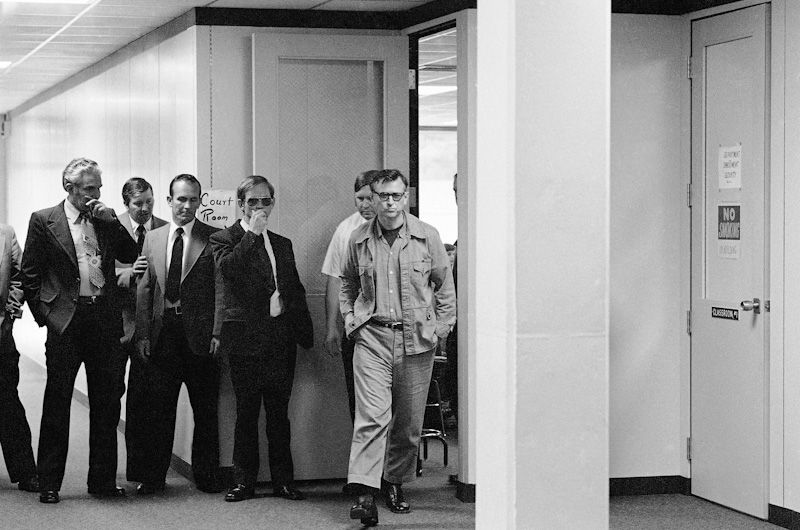Busting Out: A History Channel series focuses on great escapes

James Earl Ray (center), seen here in October 1977, received a 99-year sentence for killing Martin Luther King Jr. He received additional time in 1977, following his escape from Tennessee’s Brushy Mountain State Penitentiary. (Photo by Joe Holloway/The Associated Press)
Like many other jurisdictions, Oklahoma has various security levels within its state prison system. Perhaps unlike many other states, multiple inmates escaped in the past year, and one has yet to be caught.
Three of those inmates—Jahari Johnson, Jett Green and Adrian Sample—simply walked out. Green and Sample were recaptured but Johnson remains at large, according to news reports.
History’s Greatest Escapes with Morgan Freeman, a History Channel anthology series, devotes eight episodes to prison breakout stories, with each detailing a distinct and daring getaway. The last episode centered on James Earl Ray, the man convicted of assassinating Martin Luther King Jr. According to the description, Ray attempted multiple prison escapes. Most of the program centered around his 1977 escape from Brushy Mountain State Penitentiary in Tennessee.
I enjoyed the offering. The show detailed the planned escape and everything that went into the process. It was fairly in-depth and much more entertaining than the recent Oklahoma escapes, where the inmates simply walked away from a facility.
“Walked away? How does that happen?” you might ask.
The Department of Corrections’ different security levels bring varying degrees of restriction. Some lower security facilities have more of an “open campus” feel. Places such as the Clara Waters Community Corrections Center in Oklahoma City are designed with that “freedom” in mind—after all, the facility caters to many inmates who are transitioning out of prison.
It may seem confusing as to why someone would attempt to escape from prison when they’re so close to being lawfully released. Sometimes the itch must be scratched, though, regardless of the consequences.
What is considered ‘flight’?
When I looked at the episode list for the series, I was surprised to find that there weren’t more stories revolving around individuals who attempted to escape while their cases were pending. Instead, all the prisoners aside from those in an episode focused on people who escaped a Nazi prisoners of war camp had already been convicted and were serving their sentences.
In my mind, you wouldn’t even give the prosecution a chance to convict if you were willing to escape in the first place. Attempts to escape while a case is pending can come in the form of breaking out from the county jail or absconding from a bondsman.
However, in situations where someone tries to flee pretrial, getting caught will likely lead to a new felony charge. Not only that, but it can also lead to increased liability and an even longer delay before the inmate is released, thus negating the reason for attempting to escape in the first place. The defendant also will likely face a “flight” instruction issued to the jury during the trial for the original charge that landed them in custody.
Still, the Oklahoma Court of Criminal Appeals has found that simply fleeing is not always sufficient to prove “flight.” According to the Oklahoma Uniform Jury Instructions, flight is apparent in situations where the defendant departed, concealed themselves or escaped or attempted to escape from custody with a consciousness of guilt to avoid apprehension. The prosecution must prove those elements beyond a reasonable doubt.
And if they can, it’s a huge boon for their case.
The power of jury instructions
Why would it matter if the prosecution could get a flight instruction during a jury trial? One reason is that the jurors must prove that a defendant has a consciousness of guilt. That is part and parcel with the entire purpose of the underlying trial: To see whether sufficient evidence shows the defendant is guilty of the charged crime.
Consequently, a “consciousness” of that guilt is beneficial to achieving a conviction. If a judge gives the flight instruction, that’s a factor the jury can consider when determining the ultimate question of the defendant’s guilt.
That’s huge for closing arguments, as any skilled trial attorney will incorporate the jury instructions into their last chance at persuasion. Some of those instructions carry significant weight for the battle-tested advocate.
On the other hand, though, sometimes it seems like juries barely even read the instructions. I had a recent trial where during deliberations, the jury sent a question to the judge asking for an attorney to assist them in understanding the instructions. I know the instructions often can be complicated at first glance, but I also know that, at least in Oklahoma, we have instructions that explain and define terms used in other applicable instructions. We have instructions for the instructions.
When definitions are provided and a group of 12 adults still has issues understanding the applicable law, that makes me worry. But as a practice point, finding an instruction that works with your defense theory and building your closing around it is always beneficial.
Just be wary of the other instructions that cut against your argument, and make sure to embrace them as well. Even if the jurors don’t end up reading the instructions during deliberations, they’ll hold whatever you glaze over against your client in the end.

Adam Banner
Adam R. Banner is the founder and lead attorney of the Oklahoma Legal Group, a criminal defense law firm in Oklahoma City. His practice focuses solely on state and federal criminal defense. He represents the accused against allegations of sex crimes, violent crimes, drug crimes and white-collar crimes.
The study of law isn’t for everyone, yet its practice and procedure seems to permeate pop culture at an increasing rate. This column is about the intersection of law and pop culture in an attempt to separate the real from the ridiculous.
This column reflects the opinions of the author and not necessarily the views of the ABA Journal—or the American Bar Association.



